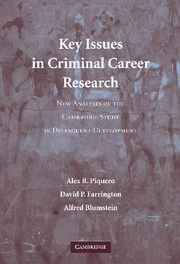 Key Issues in Criminal Career Research
Key Issues in Criminal Career Research Published online by Cambridge University Press: 30 July 2009
This final chapter integrates the main findings of the book and summarizes the “take-home” messages from the various chapters. Based on these findings, we then highlight five key priorities for future criminal career research. We readily forewarn readers that we outline a very ambitious agenda and ask difficult research questions, but we believe that the data brought to bear on those questions will open new doors for theoretical, empirical (both quantitative and qualitative), and policy research. We conclude by outlining the next 40 years of the CSDD.
Before we present these findings, we would like to take stock of the motivation behind this book. Quite frankly, we were struck by the level of agreement about some key criminal career facts that many criminologists share (e.g., Farrington, 2003). At the same time, many other observations made by criminal career researchers over the past several decades have resulted in contentious exchanges on key questions that remain contentious and/or understudied (see Sampson and Laub, 2005a, b). In particular, we identified a number of issues that we sought to address using data from the CSDD, a longitudinal study of 411 South London males followed to age 40. Although we cannot hope to answer every question in excruciating detail, we do believe that, when taken together, the results presented in this book provide a very comprehensive, descriptive portrait of the criminal careers of these men. Now, what did we ask and what did we learn about these contentious criminal career issues?
To save this book to your Kindle, first ensure [email protected] is added to your Approved Personal Document E-mail List under your Personal Document Settings on the Manage Your Content and Devices page of your Amazon account. Then enter the ‘name’ part of your Kindle email address below. Find out more about saving to your Kindle.
Note you can select to save to either the @free.kindle.com or @kindle.com variations. ‘@free.kindle.com’ emails are free but can only be saved to your device when it is connected to wi-fi. ‘@kindle.com’ emails can be delivered even when you are not connected to wi-fi, but note that service fees apply.
Find out more about the Kindle Personal Document Service.
To save content items to your account, please confirm that you agree to abide by our usage policies. If this is the first time you use this feature, you will be asked to authorise Cambridge Core to connect with your account. Find out more about saving content to Dropbox.
To save content items to your account, please confirm that you agree to abide by our usage policies. If this is the first time you use this feature, you will be asked to authorise Cambridge Core to connect with your account. Find out more about saving content to Google Drive.